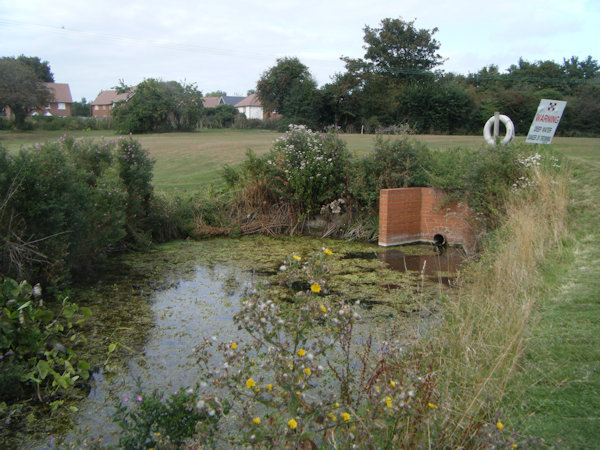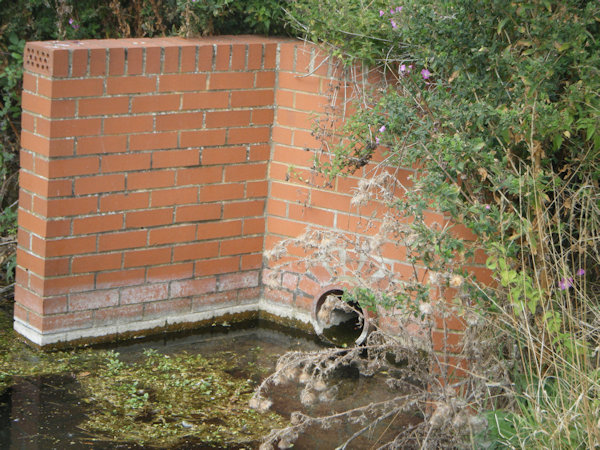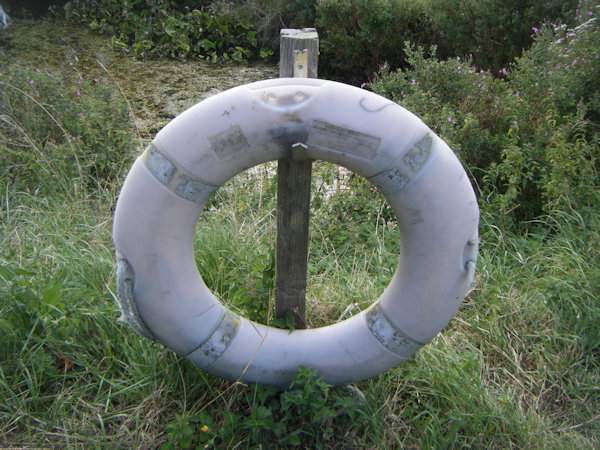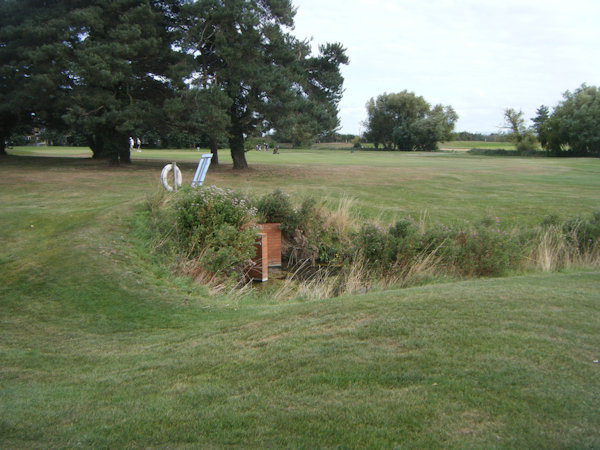 |
Dedication: Saint Augustine of Canterbury Location: St Augustine's Golf Links Coordinates: 51.32624N, 1.36267W Grid reference: TR343639 Heritage designation: none |
 |
Dedication: Saint Augustine of Canterbury Location: St Augustine's Golf Links Coordinates: 51.32624N, 1.36267W Grid reference: TR343639 Heritage designation: none |
St Augustine of Canterbury, who was most probably born at some point during the late 6th century, was selected by Pope Gregory the Great to lead the so-called "Gregorian Mission" to England. In or around the year 597*, Augustine's vessel landed at Ebbsfleet, and it was here that the Gregorian Mission began. One of Augustine's prime objectives seems to have been to convert the pagan King Ethelbert of Kent (who is not to be confused with a later saint and martyr who was also known as King Ethelbert of Kent) to Christianity. According to John Lewis, writing in 1736 in the second edition of his History and Antiquities of the Isle of Tenet [sic], King Ethelbert was then residing "at Canterbury, about 12 or 13 Miles [sic]" from Ebbsfleet, and he is rumoured to have first met with Augustine beneath a particular oak tree. After successfully converting Ethelbert and, thus, a large number of local Anglo-Saxons, he is reputed to have ventured further into England to meet with other leaders under another oak tree, which was, according to Camden, probably located somewhere in Worcestershire. Overall, Augustine's mission was a success, although his cult seems to have been superseded by those of later, more local Anglo-Saxon figures, apart from in this part of the Isle of Thanet, where he first landed.
Indeed, Augustine's medieval cult was clearly very strong in this area. Studies in Church Dedications, written by Frances Arnold-Forster in 1899, lists both the nearby church of Northbourne and the church of Stonar (which is now destroyed) as possessing a medieval dedication to the saint, and John Leland mentioned visiting, in his Itinerary, which was compiled just before the Reformation, a "little paroche church of S. Augustine" at Richborough Castle. In addition to this was the Abbey of St Augustine in Canterbury, where the saint was reputedly interred, and which possessed its own holy well of St Augustine. It is quite likely that some sort of pilgrimage route would have existed, in medieval times, linking Ebbsfleet to Canterbury.
Another interesting landmark in the vicinity of St Augustine's Well was "St Augustine's Oak", which was mentioned by the Rev. G. F. Browne in a lecture in 1895. Browne's words were recorded in the same year in Augustine and His Companions, and he reported that the this tree was traditionally said to have been "the tree under which Ethelbert received Augustine" for the first time. However, although this tradition may initially appear to be quite credible, a number of older sources, including an "ancient map" of Thanet that Browne himself referred to, indicate that the tree with which this belief was authentically linked, during the medieval period, was actually located in the centre of the island. Perhaps the legend was transferred to the tree close to St Augustine's Well at a later date, when the original tree was felled, because of its proximity to the landing place of the saint. Either way, this tree itself had been felled by the mid 19th century, and it was because of this that Lord Granville, who came into the ownership of the adjoining field, constructed a large stone cross, which still stands today, near its site.
Although there are no records regarding how St Augustine's Well would have been used during the medieval period, it undoubtedly would have been visited by pilgrims in the area. In fact, Ebbsfleet had important links with the cults of both St Augustine and St Mildred, a local saint who was active around century after Augustine, and who is also traditionally said to have landed at Ebbsfleet on her way to Kent from France. Both saints seem to have possessed "holy rocks" in the vicinity, both of which were said to bear the footprints of the saints, and which would almost certainly had been objects of pilgrimage during the medieval period. In a piece entitled Beside the Wantsume, which was published in The Gentleman's Magazine in 1899, John Edward Field claimed that this rock had borne "the print of his foot", and tradition had dictated that "if any dared to move the stone it would speedily return to its position", although, by Field's time, it had already "passed away". In all likelihood, Augustine's stone would have stood very close to the holy well.
Intriguingly, there is considerable evidence to suggest that St Augustine's Well was, at least from the early 11th century onwards, held under the possession of St Augustine's Abbey in Canterbury. In 1895, Charles Cotton wrote, in his History and Antiquities of the Church and Parish of St. Laurence, Thanet, that the land "between Stonore and Cliff's End" came "into the possession" of St Augustine's Abbey in "about the year 1027", and stayed under their control "until the dissolution". Although Cotton did not explicitly state that this land included St Augustine's Well, Ebbsfleet is situated in between the two places that he mentioned, and so would undoubtedly have been included in the land given to St Augustine's in 1027. John Lewis confirmed this in the second edition of his aforementioned History and Antiquities of the Isle of Tenet [sic], in which he recorded that "Clyveſend or Cliff-end", which is now known as "Cliffsend" and is situated in extremely close proximity to St Augustine's Well, was "antiently [sic] a Part of the Eſtate of St. Auſtin's Abby [sic]". It is probable that, if St Augustine's Well did not already exist, then it was created by the Abbey at some point after 1027 to serve as an attraction for pilgrims; either way, in all probability, the well would have been housed in some kind of chapel, and attended by the Abbey's monks.
It is, unfortunately, not clear how many of the traditions that are now linked to the well were actually known in medieval times, mainly because all of the records that I have found regarding these legends date from the late 19th century. As such, a number of the tales that were recorded, about the well, in the late 1800s, may have evolved as a result of the 19th century confusion between the oak tree in the centre of the island, and the tree near St Augustine's Well. John Edward Field, as previously mentioned, wrote in The Gentleman's Magazine in 1899 that St Augustine's Well was popularly said to have appeared after Augustine "struck" his staff "into the ground", he and his companions being thirsty after their long journey, and having been "refused" water by the locals. According to Charles Cotton, who did not mention the first legend, a large number of "the first converts among the Saxons" were baptised in the well by St Augustine. It is quite possible that both of these legends were associated with the site in medieval times.
Irrespective of potential medieval legends that were linked to the site, St Augustine's Well was clearly held in great local repute for some time after the Reformation. Kelly's Guide to the Isle of Thanet, published in 1900, makes reference to an undated "manuscript of Dr. Rowland Freeman" that states the following:
|
About a furlong south of this oak, nearer the sea, is a beautiful spring of water, which was formerly called St. Augustine's Well, and, sixty years ago, when Ramsgate was rising into a town, a Mr. Pettit of Cliffs End carried the water into Ramsgate and sold it. |
According to the Guide, Mr Pettit thus earned himself the name of "Old Aquarius", although the sale of the water in Ramsgate seems to have stopped after his death. This was not the end for the water of St Augustine's Well, however, as, on the 12th of September, 1919, The Hongkong Telegraph reported on a "New Mineral Spring Discovered in Kent", which it claimed would be a "rival to German industry". This paper states that a Mr. W. T. Puddepha, who seems to have previously held a high-up position at a soda water factory in Hong Kong, discovered St Augustine's Well by chance (after reading Kelly's Guide), and was instantly impressed by its quality:
|
In brief the flow from the spring has been found to be a most magnificent natural water of extreme purity, as clear as crystal, and expert advice shows that when aerated it will form a table water of the very highest possible quality. To trace the events which led up to that discovery the past has not to be traversed very far. Just prior to the outbreak of the war, Mr. W. T. Puddepha, a gentleman of wide experience in the aerated water trade, came to Ramsgate and acquired the business of the Ozonic Mineral Water Company from Mr. Dyer. He had for long been searching the country for a spring of really pure water for bottling purposes, but without success, and on arrival in Ramsgate had almost given up in despair of ever finding one. Then, one day, on glancing through the introduction to Kelly's street directory to the Isle of Thanet, he came across brief reference to St. Augustine's baptismal spring at Ebbsfleet. Little thinking he was to find by chance what he had been seeking methodically without success, he located the outlet after a long search. The site is on the St. Augustine's golf links, near the Sportsman Inn. |
The paper went on the confirm that Mr Puddepha had privately raised "£20,000" (equivalent to roughly £781,000 today), and had "acquired", presumably from the golf course, both "the spring site" and a "piece of land nearby for building purposes", as well as forming "a small company" centred around bottling the well's water. As such, it was asserted that St Augustine's Well "will shortly be enclosed", and there were plans for "the necessary bottling works" to be constructed "close to the Sportsman Inn, facing the Sandwich-road", as soon "as possible". Mr Puddepha clearly had great confidence in this new enterprise, the paper claiming that it was "safe to prophesy" that water from the holy well "will be consumed not only in all parts of this country, but in every civilised land", within a "few years", and it was even suggested that the erection of a "pump-room" at the site would be under "serious consideration" once the company was "operative".
Needless to say, Mr Puddepha's plans must have quietly fallen through, because no bottling plant was ever established at the site, the spring was never "enclosed", and it appears that he must have sold the land back to the golf course, because it now forms part of the course. Nevertheless, St Augustine's Well remains a relatively well-known site, and it is still named on current Ordnance Survey maps, as well as having been marked on historic ones. In fact, according to the records of OS surveyors, dating from 1963, the spring was once accompanied by a small plaque inscribed with the following text:
|
St. Augustine's Well. This is the traditional spot where St. Augustine camped with his monks on reaching England in the spring of the year 597. A legend arose that water sprang up where St. Augustine planted his staff. |
When I visited the well for myself in August 2025, this plaque was very clearly long-gone, the area having evidently been extensively landscaped. Regardless of this, the woman behind the clubhouse bar knew of its name, and kindly directed me towards it. Although it is obvious that there is, unfortunately, nothing left of the well's original structure, the spring was clearly still strong, and fed a large stream that meandered through the course. The water itself issued from a large pipe, embedded into a clearly recent brick wall, and fed a large pond. There were no signs or notices in the vicinity denoting its historical importance. There were a number of golf balls at the bottom of this pool, and, as I was leaving the site, I saw another splash into the water.
 |
 |
 |
 |
|
Access: Permission is to be obtained from the golf course before visiting St Augustine's Well. Because of its location, visiting the site is inherently dangerous, so great care should be taken to avoid being hit by golf balls! |
*597 appears to be, today, the accepted date for this event, despite the fact that older sources (those predating the late 19th century) generally give a date of 596 for the landing. Augustine was chosen for the Gregorian Mission in 595, and, as the journey from Rome would have taken a very long time when Augustine was travelling, it is quite plausible that he could have arrived in either year.
Copyright 2025 britishholywells.co.uk